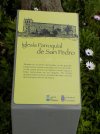This is part of what the sources say: La torre es prismática, de cuatro alturas, con tejado a cuatro aguas y bolas herrerianas en los ángulos.
Google has helped to translate it: The tower is prismatic, four storeys high, with a hipped roof and Herrerian balls in the corners.
But I'm curious. Why don't they say that the tower is square -- cuadrado, cuadrangular? Why don't they say 'de cuatro pisos'? My very decent Spainsh-English dictionary doesn't give 'storey' as a translation for 'altura'. I though it meant that the tower had four stages, visible from the outside, but it only has one 'break', just below the windows of the belfry. It's rather clever that GT can know that 'a cuatro aguas' means 'hipped'.
Google has helped to translate it: The tower is prismatic, four storeys high, with a hipped roof and Herrerian balls in the corners.
But I'm curious. Why don't they say that the tower is square -- cuadrado, cuadrangular? Why don't they say 'de cuatro pisos'? My very decent Spainsh-English dictionary doesn't give 'storey' as a translation for 'altura'. I though it meant that the tower had four stages, visible from the outside, but it only has one 'break', just below the windows of the belfry. It's rather clever that GT can know that 'a cuatro aguas' means 'hipped'.















